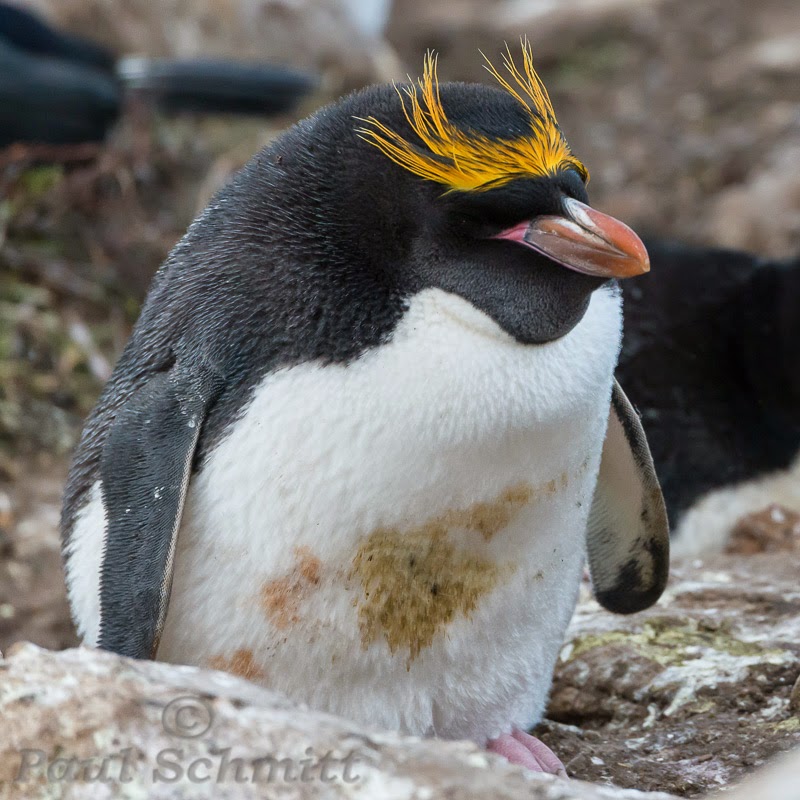
Nevertheless, most of the first-laid eggs (A-eggs) are lost during incubation. A small nest is build from tussock, peat and pebbles. Separation of juvenile Southern and Northern Rockhopper Penguins in the field is probably impossible.īreeding colonies are located on rocky slopes and amongst tussocks, sometimes in small caves and amongst crevices. Shape of the supercilium, bill shape, body size and underwing pattern can aid identification. Identification of juveniles is difficult. Immature birds have only a narrow supercilium and a pale mottled grey chin.
Macaroni penguin rockhopper skin#
The eastern form mainly differs from the nominate subspecies in having a pink line of fleshy skin along the lower mandible which is black in the nominate subspecies. The Southern Rockhopper actually comprises two subspecies that have been described and can be identified in the field: the nominate form from South America and the Falkland Islands and the eastern subspecies filholi from the New Zealand sub-Antarctic islands. Southern Rockhopper Penguins differ from their Northern counterparts in having a narrower supercilium and shorter plumes, which reach just over the black throat. The feather plumes are yellow, not orange as in Macaroni Penguin, and thinner than in the remaining Eudyptes species.

The chicks are often easy to pick out as they are brown and fluffy. While one parent watches over the chick, the other parent will get food and store it in its mouth to feed the chick.

They also stay close to the eggs and newborn chicks to protect them from predators. Each parent penguin takes a turn sitting on the egg, or eggs, to keep them warm. Sometimes there will be thousands of penguins at the same place. At spring they return to the same place every year and lay eggs.

Some penguins mate for life, while others mate for a season. They also eat krill, squid, crustaceans, and octopus. What types of fish they eat can depend on where they live. Likewise, their black backs help disguise them from above as they are hard to see against the water and the dark ocean bed. When swimming in the ocean, their white stomachs make them hard to see from below as they blend into the sky and sunlight above. All Penguins are mostly black and white in coloring, which provides an excellent camouflage in the water. On land they can waddle along on their hind feet or slide quickly on the ice on their stomachs. It is small, typically weighing around 5 pounds fully grown. Rockhopper Penguin - Found in the Antarctic, this crested penguin has different colored feathers on its head.They live in the cooler areas like the Antarctic. They grow to about 28 inches tall and 11 pounds. Macaroni Penguin - This penguin is famous for its long orange feathers on top of its head.Galapagos Penguin - One of the smallest penguins at only 20 inches tall and 5 pounds fully grown, it lives on the Galapagos Islands.King Penguin - The second largest penguin, the King lives in the Antarctic as well as the Falkland Islands, Australia, and New Zealand.Emperor Penguin - This is the largest of the penguins growing to over 3 feet tall.It lives in the Antarctic in large colonies. Adelie Penguin - This penguin is short, but wide.Here is a brief description of some of the different types of penguins: The largest of the penguins is the Emperor penguin which is over three feet tall. Perhaps the Macaroni penguin has the most unusual of these markings as it has long orange feathers right on top of its head. You can tell these different types of penguins apart by the unique markings on their heads.

There are several different types of penguins including the Rockhopper, Macaroni, Adelie, Gentoo, Chinstrap, Emperor, King, and the Little Penguin.


 0 kommentar(er)
0 kommentar(er)
